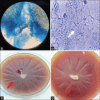Outcomes of keratoplasty in a cohort of Pythium insidiosum keratitis cases at a tertiary eye care center in India
- PMID: 39078955
- PMCID: PMC11451789
- DOI: 10.4103/IJO.IJO_3108_23
Outcomes of keratoplasty in a cohort of Pythium insidiosum keratitis cases at a tertiary eye care center in India
Abstract
Purpose: To assess outcomes of keratoplasty performed in patients diagnosed with keratitis caused by Pythium insidiosum (PI).
Design: Retrospective review.
Methods: Preoperative, intra operative and post operative data of patients diagnosed with PI keratitis and who underwent keratoplasty for their condition from January 2020 to December 2021 were collected from the central patient database of a tertiary eye care hospital in India. The data were analyzed for anatomic success, elimination of infection, graft survival, incidence of repeat keratoplasty, final visual acuity and varied complications.
Results: In total, 16 eyes underwent penetrating keratoplasty for PI keratitis during the study period. Mean time to keratoplasty from onset of symptoms was 31.3 days and mean graft size was 10.4 mm. Nine out of the 16 cases had recurrence of infection following surgery, seven of which required a repeat keratoplasty for elimination of infection. Mean graft size for repeat keratoplasty performed in recurrent cases was 11.7 mm. Globe was successfully salvaged in 14 out of 16 patients (87.5 %). Three grafts remained clear at 6-month follow up while 11 grafts failed. Mean improvement in uncorrected visual acuity from 2.32 to 2.04 logMAR was observed at last follow up. Endo-exudates, graft infiltration, graft dehiscence, secondary glaucoma and retinal detachment were the various complications noted after keratoplasty.
Conclusion: PI keratitis is a tenacious and potentially blinding condition. Keratoplasty remains the choice of treatment in this condition, however recurrence of disease and graft failure are common. Large sized grafts, meticulous per-operative removal of infection, adjuvant cryotherapy, and intraoperative and post operative use of antibiotics can help in improving outcome of keratoplasty in these patients.
Copyright © 2024 Copyright: © 2024 Indian Journal of Ophthalmology.
Conflict of interest statement
There are no conflicts of interest.
Figures




References
-
- Gaastra W, Lipman LJ, De Cock AW, Exel TK, Pegge RB, Scheurwater J, et al. Pythium insidiosum: An overview. Vet Microbiol. 2010;146:1–16. - PubMed
MeSH terms
LinkOut - more resources
Full Text Sources
Research Materials
Miscellaneous

